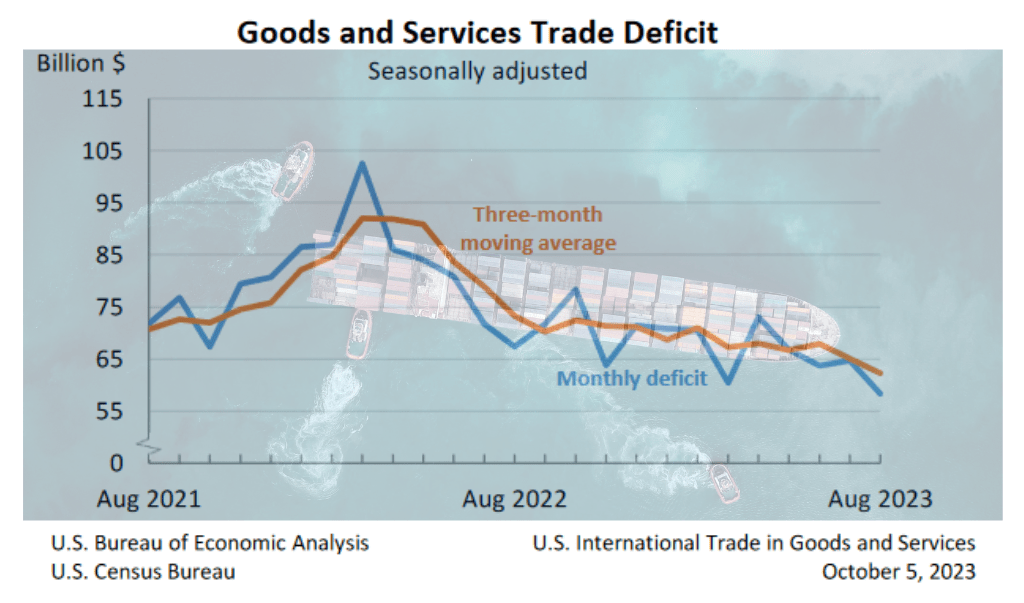As yet another sign of tightening capital and a slowing economy, the U.S. saw a slight 0.7% retraction in imports for the month of August, while exports rose 1.6% thanks to three items mainly – oil, auto parts, and capital goods equipment made in the U.S. and sold elsewhere. It was those higher export values that helped push down the monthly goods and services trade deficit by 9.9% to $58.3 billion, the lowest monthly deficit recorded so far this year, according to the Bureau of Economic Analysis.
For goods alone, the August deficit was $84.4 billion, down from the revised $89.9 billion in July. August’s deficit in goods was the second lowest this year. The lowest goods gap with the world for 2023 came in March – $81.4 billion.
So far this year, the U.S. goods trade deficit stands at $712.84 billion. If the U.S. were to post a low $81 billion goods deficit per month for the next four months, then the U.S. will still finish the year with a goods deficit over one trillion dollars, for the third consecutive year.
The Bureau of Economic Analysis does not provide any analysis as to why the trade deficit goes up or down in any given month. But headlines in the financial press about tighter credit and rumors of a recession may be one explanation as to why the trendline for the goods and services deficit is in decline. However, despite the small fall in imports, the goods deficit shows no evidence of economic weakening or difficulty in obtaining credit to finance imports.
Of note, the European Union surpassed Mexico as the No. 2 source of our trade deficit after China. The August trade deficit with the EU was $19.54 billion. It is $139.33 billion on the year, which beats our $100.73 billion goods gap with Mexico year-to-date.
Our top imports from EU nations are pharmaceuticals and automotive parts and vehicles. Economists often like to point out that one of the reasons for the U.S. trade deficit is because the U.S. is a large, rich country with a massive consumer class. While this is true, one can arguably say the same for Western Europe. Yet, Western Europe, led by Germany, has a yawning trade gap with the U.S. Germany’s trade surplus with the U.S. stands at $55 billion so far this year, which is half that of Mexico, a country with which the U.S. has a free trade agreement.
United States Biggest Trade Imbalances
| Country | August 2023 | July 2023 | YTD |
| China | $25.95 billion | $25.44 billion | $181.77 billion |
| Mexico | $12.74 billion | $12.49 billion | $100.73 billion |
| Vietnam | $9.41 billion | $9.34 billion | $66.68 billion |
| Germany | $7.09 billion | $7.44 billion | $55.80 billion |
| Ireland | $5.75 billion | $6.46 billion | $43.27 billion |
Vietnam continues its meteoric rise as a key source of goods coming out of Asia. Much of this went into high gear around 2018, when companies moved supply out of mainland China. This included foreign companies finding new partners in Vietnam to avoid tariffs, and Chinese companies setting up shop as well in order to maintain its business relationships with the U.S. Vietnam is not a big importer of U.S. goods. Its currency is worth pennies on the dollar, and at this trend rate, it will likely rival Mexico as a source for goods. Vietnam is mostly known for kitchen cabinetry, furniture, apparel, some home electronic appliances, and solar panels.
One thing is clear, as the Vietnam example shows, the manufactured goods supply chain is leaving China.
The U.S. recorded a $271.26 billion deficit with China in the eight months ending August 2022, and we are down nearly 100 billion dollars from that to $181.77 billion this year. Where has it gone?
The goods deficit with Mexico was $84.1 billion at this time in 2022 (now roughly $20 billion more), the goods deficit with the EU was $126.70 billion ($13 billion more today in 2023), but the goods deficit with Vietnam was much larger last year – $79.03 billion for the year ending August 2022.
“The trade deficit is somewhat smaller than last year as consumer spending is slowing down and consumers are spending more of their cash on energy and mortgage repayments,” said CPA chief economist Jeff Ferry. “However with the dollar on another upswing from its already overvalued levels, and the likelihood of an onslaught of cheap Chinese electric vehicle imports, the trade deficit is likely to get worse. It represents a trillion dollars of U.S. demand lost to foreign importers that should go instead to U.S. producers.”
Years ago, Washington decided the U.S. was better off as a services economy.
But when it comes to trade, the trade surplus in services — which includes financial transactions and licensing fees for downloaded software products — would have to grow three-fold to make up for the deficit in goods, assuming the deficit it goods did not grow at all.
For up-to-date monthly trade data, visit the CPA Trade Database.













